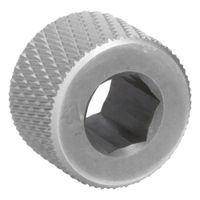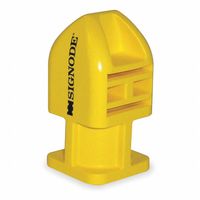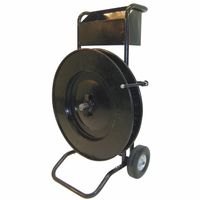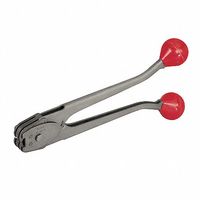Call +(254) 703 030 000 / 751 483 999 / 721 704 777
- Home
- Packaging Shipping
- Strapping
.....Read More
Frequently Asked Questions
What are the different types of strapping materials available?
Strapping materials are essential for securing and bundling items during storage and transportation. The main types of strapping materials include:
1. **Polypropylene (PP) Strapping**: Lightweight and economical, PP strapping is suitable for light to medium-duty applications. It is flexible, easy to handle, and resistant to moisture, making it ideal for packaging boxes and bundling newspapers.
2. **Polyester (PET) Strapping**: Known for its high tensile strength and elongation, PET strapping is used for heavy-duty applications. It is a popular alternative to steel strapping due to its resistance to UV rays and ability to maintain tension over time, making it suitable for securing heavy loads like bricks and lumber.
3. **Nylon Strapping**: Offering high strength and elasticity, nylon strapping is used in applications requiring high tension retention. It is more expensive than other plastic strapping materials and is often used in cold environments due to its resistance to low temperatures.
4. **Steel Strapping**: The strongest strapping material, steel is used for heavy-duty applications requiring high tensile strength and minimal stretch. It is ideal for securing heavy loads, such as industrial equipment and construction materials, but is prone to rust and requires careful handling to avoid injury.
5. **Corded and Woven Strapping**: Made from polyester fibers, these strapping types offer high strength and flexibility. They are often used in applications where traditional steel strapping might damage the product, such as in the lumber and glass industries.
6. **Composite Strapping**: Combining the strength of steel with the flexibility of polyester, composite strapping is used for heavy-duty applications. It is resistant to weather conditions and is often used in the shipping and logistics industry.
Each type of strapping material has its specific applications, advantages, and limitations, making it important to choose the right one based on the requirements of the task.
How do I choose the right strapping material for my application?
To choose the right strapping material for your application, consider the following factors:
1. **Load Type and Weight**: Determine the weight and type of load. Heavy loads like bricks or metal require steel strapping, while lighter loads like boxes or newspapers can use polypropylene or polyester.
2. **Tension Requirements**: Assess the tension needed. Steel strapping offers high tensile strength for rigid loads, while polyester provides good tension retention for medium to heavy loads. Polypropylene is suitable for light to medium loads.
3. **Environmental Conditions**: Consider exposure to elements. Polyester and polypropylene resist moisture and UV rays, making them ideal for outdoor use. Steel is prone to rust unless coated.
4. **Cost**: Evaluate budget constraints. Polypropylene is the most economical, followed by polyester. Steel is generally more expensive but necessary for certain applications.
5. **Safety**: Consider safety during application and removal. Polyester and polypropylene are safer to handle than steel, which can have sharp edges.
6. **Recyclability and Sustainability**: If environmental impact is a concern, choose recyclable materials. Polyester and polypropylene are recyclable, while steel is also recyclable but less eco-friendly due to energy-intensive production.
7. **Application Method**: Determine if manual or machine application is needed. Polypropylene and polyester are suitable for both, while steel often requires specialized tools.
8. **Elongation and Recovery**: Consider the material's ability to stretch and recover. Polyester offers good elongation and recovery, making it suitable for loads that may expand or contract.
9. **Abrasion Resistance**: For loads with sharp edges, steel or polyester may be more appropriate due to their higher abrasion resistance compared to polypropylene.
By evaluating these factors, you can select the strapping material that best meets your specific application needs.
What are the benefits of using strapping machines over manual strapping?
Strapping machines offer several advantages over manual strapping, enhancing efficiency, consistency, and safety in packaging operations.
Firstly, strapping machines significantly increase productivity. They automate the strapping process, allowing for faster application compared to manual methods. This speed is crucial in high-volume operations, reducing bottlenecks and improving throughput.
Secondly, they ensure consistent tension and seal quality. Manual strapping can lead to variations in tension, which might compromise package integrity. Strapping machines apply uniform tension and secure seals, ensuring that packages are consistently strapped to the desired specifications, reducing the risk of damage during transit.
Thirdly, strapping machines reduce labor costs and physical strain. Manual strapping is labor-intensive and can lead to repetitive strain injuries. By automating the process, businesses can reallocate labor to other tasks, improving overall operational efficiency and reducing the risk of workplace injuries.
Additionally, strapping machines enhance safety. They minimize the need for workers to handle sharp tools or heavy loads, reducing the risk of accidents. Automated machines also often come with safety features that prevent misuse or accidents.
Moreover, they offer versatility and adaptability. Strapping machines can handle various strap materials and sizes, accommodating different packaging needs. This flexibility is beneficial for businesses that deal with diverse products and packaging requirements.
Finally, strapping machines contribute to cost savings in the long run. Although the initial investment might be higher, the reduction in labor costs, increased efficiency, and decreased material waste lead to significant savings over time.
In summary, strapping machines provide enhanced efficiency, consistency, safety, and cost-effectiveness, making them a superior choice over manual strapping in many industrial and commercial settings.
How do I properly tension and seal strapping?
To properly tension and seal strapping, follow these steps:
1. **Select the Right Strapping**: Choose the appropriate type (steel, polyester, polypropylene) and width based on the load requirements.
2. **Position the Strapping**: Wrap the strapping around the package or pallet. Ensure it is positioned correctly, typically horizontally and/or vertically, depending on the load stability needed.
3. **Thread the Strapping**: Pass the strapping through the buckle or seal. For metal seals, overlap the strapping ends by a few inches.
4. **Tension the Strapping**:
- **Manual Tensioner**: Place the tensioner on the strapping. Crank the handle to tighten until the desired tension is achieved. Ensure the strapping is taut but not overly tight to avoid damaging the package.
- **Battery/Electric Tensioner**: Insert the strapping into the tool. Press the button to automatically tension the strapping to the preset level.
5. **Seal the Strapping**:
- **Manual Sealer**: Place the seal over the overlapped strapping ends. Use a sealer tool to crimp the seal tightly, ensuring it holds the strapping securely.
- **Combination Tool**: If using a combination tool, it will tension, seal, and cut the strapping in one operation. Follow the tool’s instructions for proper use.
- **Heat Sealing**: For plastic strapping, use a heat sealer to melt and fuse the ends together.
6. **Cut the Excess Strapping**: Use a cutter to trim any excess strapping beyond the seal. Ensure the cut is clean to prevent sharp edges.
7. **Inspect the Seal**: Check the seal for security. It should be firm and not easily moved or loosened.
8. **Safety Check**: Ensure all tools are safely stored and the work area is clear of strapping remnants to prevent accidents.
What are the common tools used for manual strapping?
Common tools used for manual strapping include:
1. **Tensioners**: These are used to tighten the strap around the package or pallet. They come in different types depending on the strap material, such as steel, polyester, or polypropylene.
2. **Sealers**: Also known as crimpers, these tools are used to seal the strap after it has been tensioned. They work by crimping a seal or buckle to hold the strap in place.
3. **Combination Tools**: These are versatile tools that combine the functions of tensioning, sealing, and cutting into one device. They are convenient for operators who need to perform all three tasks quickly.
4. **Cutters**: These are used to cut the strap to the desired length. They are essential for ensuring that the strap fits snugly around the package.
5. **Buckles and Seals**: These are not tools per se, but essential components used in manual strapping. Buckles are used with tensioners to secure the strap, while seals are crimped with sealers to hold the strap in place.
6. **Strap Dispensers**: These are used to hold and dispense the strapping material, making it easier to handle and reducing the risk of tangling.
7. **Edge Protectors**: These are used to protect the edges of the package from damage by the strap. They are placed under the strap at the corners of the package.
8. **Manual Strapping Kits**: These kits typically include a tensioner, sealer, cutter, and a supply of seals and strapping material, providing everything needed for manual strapping in one package.
How do I maintain and care for strapping tools and machines?
To maintain and care for strapping tools and machines, follow these steps:
1. **Regular Cleaning**: After each use, clean the tools and machines to remove dust, debris, and strapping residue. Use a soft cloth and, if necessary, a mild detergent. Ensure all parts are dry before storage to prevent rust.
2. **Lubrication**: Regularly lubricate moving parts with appropriate oil or grease to ensure smooth operation. Focus on joints, gears, and any other moving components. Follow the manufacturer's recommendations for lubrication frequency and type.
3. **Inspection**: Conduct routine inspections to check for wear and tear. Look for signs of damage such as cracks, worn-out parts, or loose screws. Pay special attention to tensioning mechanisms and cutting blades.
4. **Blade Maintenance**: Keep cutting blades sharp for efficient operation. Replace blades that are dull or damaged to ensure clean cuts and prevent strain on the machine.
5. **Calibration**: Regularly calibrate tension settings to ensure consistent strapping tension. Incorrect tension can lead to ineffective strapping or damage to the product.
6. **Storage**: Store tools and machines in a dry, clean environment. Protect them from extreme temperatures and humidity, which can cause corrosion and damage.
7. **Training**: Ensure operators are trained in the correct use and maintenance of the equipment. Proper handling reduces the risk of damage and extends the lifespan of the tools.
8. **Follow Manufacturer Guidelines**: Adhere to the maintenance schedule and guidelines provided by the manufacturer. This includes using recommended parts and accessories.
9. **Professional Servicing**: Schedule regular professional servicing to address complex maintenance tasks and repairs. This ensures the equipment remains in optimal condition.
10. **Record Keeping**: Maintain a log of maintenance activities, including cleaning, lubrication, inspections, and repairs. This helps track the condition of the equipment and plan future maintenance.
What are the safety precautions when using strapping products?
When using strapping products, several safety precautions should be observed to ensure safe handling and application:
1. **Personal Protective Equipment (PPE):** Always wear appropriate PPE, including safety glasses, gloves, and steel-toed boots, to protect against potential injuries from sharp edges or snapping straps.
2. **Training:** Ensure all personnel are adequately trained in the use of strapping tools and equipment. Understanding the correct techniques reduces the risk of accidents.
3. **Inspect Equipment:** Regularly inspect strapping tools and materials for damage or wear. Faulty equipment can lead to malfunctions and injuries.
4. **Proper Handling:** Handle strapping materials carefully to avoid cuts or abrasions. Use tools designed for cutting and tensioning to minimize direct contact with the strap.
5. **Correct Tensioning:** Apply the correct tension to avoid over-tightening, which can cause the strap to snap, or under-tightening, which can lead to load instability.
6. **Secure Work Area:** Ensure the work area is clean and free of obstructions. A cluttered environment can lead to tripping hazards and impede safe operation.
7. **Load Stability:** Verify that the load is stable before and after strapping. Unstable loads can shift and cause injury during transport or handling.
8. **Use Appropriate Strapping:** Select the correct type and size of strapping for the load. Using inappropriate strapping can lead to failure and accidents.
9. **Cutting Straps Safely:** When cutting straps, stand to the side and use tools designed for the purpose to prevent recoil injuries.
10. **Storage:** Store strapping materials properly to prevent damage and ensure they are in good condition when needed.
11. **Emergency Procedures:** Have clear emergency procedures in place and ensure all workers are familiar with them in case of an accident.
By adhering to these precautions, the risk of injury and accidents when using strapping products can be significantly reduced.
How do I calculate the amount of strapping needed for a specific job?
To calculate the amount of strapping needed for a specific job, follow these steps:
1. **Determine Package Dimensions**: Measure the length, width, and height of the package or pallet you need to strap.
2. **Calculate Perimeter**: For a single strap around the package, calculate the perimeter. If strapping horizontally, use the formula:
- Perimeter = 2 * (Length + Width)
If strapping vertically, use:
- Perimeter = 2 * (Width + Height)
3. **Add Overlap**: Add extra length for overlap to secure the strap. Typically, add 12-18 inches (30-45 cm) for manual strapping or follow the strapping tool's specifications.
4. **Determine Number of Straps**: Decide how many straps are needed. This depends on the weight and stability required. Commonly, two horizontal and two vertical straps are used.
5. **Calculate Total Strapping Length**: Multiply the perimeter (including overlap) by the number of straps. For example, if using four straps, multiply the single strap length by four.
6. **Account for Waste**: Add a percentage for waste, typically 5-10%, to ensure you have enough material.
7. **Convert to Roll Length**: If strapping is sold by the roll, convert the total length needed into the number of rolls required. Divide the total length by the length of one roll.
By following these steps, you can accurately determine the amount of strapping needed for your job, ensuring you have enough material to secure your packages effectively.
What are the differences between seals and buckles in strapping?
Seals and buckles are both used in strapping to secure and tighten straps around packages or pallets, but they differ in design, application, and functionality.
Seals:
1. **Design**: Seals are small metal or plastic clips that are crimped onto the strapping material to hold it in place.
2. **Application**: They require a sealing tool or crimper to apply. The tool compresses the seal around the overlapping ends of the strap, creating a secure joint.
3. **Material Compatibility**: Seals are commonly used with steel and some types of plastic strapping.
4. **Strength**: They provide a strong, permanent bond, ideal for heavy-duty applications.
5. **Types**: Open seals (applied before tensioning) and closed seals (applied after tensioning) are available.
6. **Cost**: Generally, seals are less expensive than buckles but require additional tools for application.
Buckles:
1. **Design**: Buckles are looped fasteners that allow the strap to be threaded through and tightened manually.
2. **Application**: They do not require special tools for application, making them user-friendly and convenient for quick adjustments.
3. **Material Compatibility**: Buckles are typically used with polypropylene and polyester strapping.
4. **Strength**: They offer adjustable tension and are suitable for medium to light-duty applications.
5. **Types**: Wire buckles, plastic buckles, and metal buckles are available, each suited for different strapping materials and strengths.
6. **Cost**: Buckles can be more expensive than seals but save on tool costs and offer reusability.
In summary, seals provide a strong, permanent solution for heavy-duty strapping, while buckles offer flexibility and ease of use for lighter applications. The choice between them depends on the specific requirements of the strapping task, including the type of material, desired strength, and cost considerations.
How do I troubleshoot common issues with strapping machines?
To troubleshoot common issues with strapping machines, follow these steps:
1. **Check Power Supply**: Ensure the machine is plugged in and the power switch is on. Verify that the circuit breaker hasn't tripped.
2. **Inspect Strapping Material**: Confirm that the correct type and size of strapping material is loaded. Check for any tangles or jams in the feed path.
3. **Examine Tension Settings**: Adjust the tension settings if the strap is too loose or too tight. Refer to the machine's manual for optimal settings.
4. **Clean the Machine**: Remove any dust, debris, or strap remnants from the machine, especially around the feed rollers and sealing area.
5. **Check Sensors and Switches**: Ensure all sensors and switches are functioning properly. Clean or replace them if they are dirty or faulty.
6. **Inspect the Sealing Mechanism**: If the strap is not sealing correctly, check the heating element for wear or damage. Replace it if necessary.
7. **Lubricate Moving Parts**: Regularly lubricate gears, rollers, and other moving parts to prevent friction and wear.
8. **Verify Feed Rollers**: Ensure feed rollers are clean and not worn out. Replace them if they are not gripping the strap properly.
9. **Test the Cutter**: If the strap is not cutting, inspect the cutter blade for sharpness and alignment. Replace or adjust as needed.
10. **Review Error Codes**: Consult the machine's manual for any error codes displayed and follow the recommended troubleshooting steps.
11. **Consult the Manual**: Always refer to the machine's manual for specific troubleshooting tips and maintenance guidelines.
12. **Contact Support**: If issues persist, contact the manufacturer or a professional technician for assistance.








